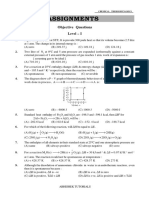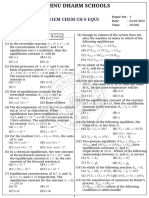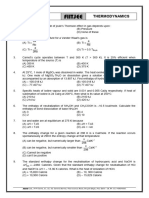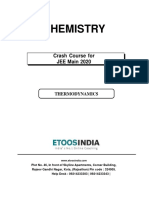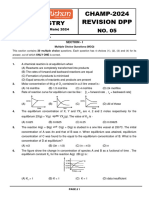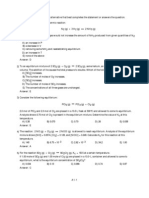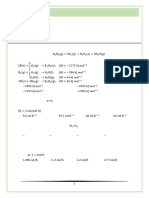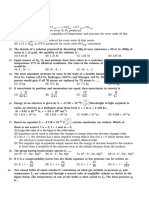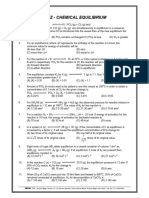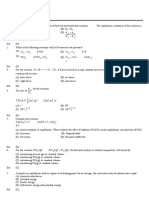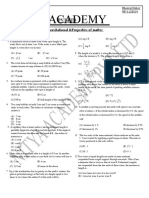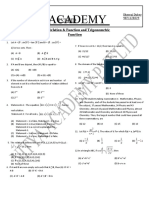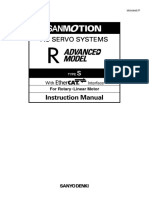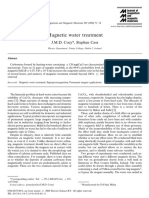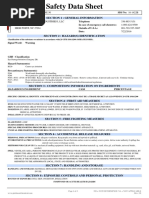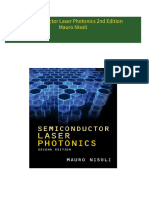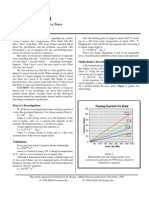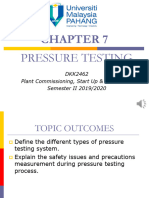Thermodynamic Test
Uploaded by
Rk kashyapCopyright:
Available Formats
Thermodynamic Test
Uploaded by
Rk kashyapOriginal Title
Copyright
Available Formats
Share this document
Did you find this document useful?
Is this content inappropriate?
Copyright:
Available Formats
Thermodynamic Test
Uploaded by
Rk kashyapCopyright:
Available Formats
DheerajDubey
NITYA ACADEMY
NITYA ACADEMY PVT.LTD
9871128329
PVT.LTD
THERMODYNAMICS
1. Given that bond energies of H-H and Cl-Cl 7. The heat of combustion of C, H2, and CH4
are 430 kJ mol-1 and 240 kJ mol-1 , are 349.0, -241.8 and -906.7 kJ/mol,
respectively and ∆ fH for HCl is -90 kJ mol-1. respectively. The heat of formation of CH4, is
The bond enthalpy of HCl is (A) 74.1 kJ/mole (B) 174.1 kJ/mole
(A) 245 kJ mol-1 (B) 290 kJ mol-1 (C) 274.1 kJ/ mole (D) 474.1 kJ/ mole
-1
(C) 380 kJ mol (D) 425 kJ mol-1
8. The value of ∆ G° for a reaction having Keq =
2. What is the entropy change (in J Kol-1 mol-1) 1 would be
when one mole of ice is converted into water (A) -RT (B) -1
at 0° C ? (The enthalpy change for the (C) 0 (D) +RT
conversion of ice to liquid water is 6.0 KJ mol 9. If for the heterogeneous equilibrium
at 0° C ) CaCO3(s) ⇌ CaO(s) + CO2(s)
(A) 20.1 (B) 2.013 K = at 1 atm the temperature is given by
(C) 2.198 (D) 21.98 ∆S ∆H
(A) T = (B) T=
3. For which reaction, the change of entropy ∆H ∆S
will be positive ? ∆G ∆G
(C) T = (D) T =
(A) H2(g) + I2(g) ⇌ 2H1(g) R ∆ H°
(B) HCl(g) + NH3(g) ⇌ NH14Cl(s) 10. When temperature of a reaction is changed
(C) NH4NO3(s) ⇌ N2O(g) + 2H2O(g) from T1 to T2, half is found to decrease. Thus,
(D) MgO(s) ⇌ Mg(g)+ H2O(l) (A) T1> T2 and reaction is endothermic
4. For the reaction, N2(g) + 3H2, (g)⟶ 2NH, (B) T2> T1 and reaction is exothermic
(g) ∆ H 95.3 kJ and ∆ S = 198.3 Jk-1 Find out (C) T1> T2 and reaction is exothermic
the temperature at which the reaction will (D) T1> T2 and reaction can be exothermic
proceed in forward direction. or endothermic
(A) T<480.6 K (B) T>480.6 K 11. Increasing the temperature of the closed
(C) T<2078 K (D) T>207 K system to 35° C would be expected to
5. A hypothetical reaction, A → 2B, proceed produce all of the changes listed below,
through following sequence of steps: except
A → C ; ∆ H = q1 (A) an increase in pressure of the vapour
C→ D; ∆ H = q2 phase
1 (B) an increase in pressure of the vapour
D→ B; ∆ H = q3
2 phase
The heat of reaction for A → 2B is (C) an increase in average kinetic energy of
(A) q1 – q2 + 2q3 (B) q1 + q2 - 2q3 system
(C) q1 + q2 + 2q3 (D) q1 + q2 - 2q3 (D) None of the above
6. The entropy change involved in the 12. Out of following, the correct for adsorption
isothermal reversible expansion of 2 moles of gaseswill be ?
of an ideal gas volume of 10 l at 27° C is
(A) 38.3 J/mol keivin (a) ∆S < 0 (b) ∆G < 0
(B) 383 J/mol keivin (c) ∆ H < 0 (d) ∆ Stotal < 0
(C) 3.83 J/mol keivin (A) a, b (B) a, b, c
(D) 3830 J/mol keivin (C) a, b, c, d (D) b, d
-------------------------------- C – 1/10, YAMUNA VIHAR, DELHI – 110053----------------------------
--------------KRISHNA NAGAR - K-69 CHHACHHI BUILDING CHOWK DELHI-110051----------
NITYA ACADEMY PVT.LTD
13. Heat of formation of water is 260 kJ. How (C) ≥0 (D) =0
water is decomposed by 130 kJ of heat ?
23. Under which of the following sets of
(A) 0.25 mol (B) 1 mol
condition, ∆ G is always negative ?
(C) 0.5 mol (D) 2 mol
(A) ∆ H = -ve and ∆ S = +ve
14. The amount of heat evolved when 500 cm3, (B) ∆ H = -ve and ∆ S = -ve
0.1 M HCl is mixed with 200 cm3 at 0.2 (C) ∆ H = +ve and ∆ S = +ve
MNaOH is (D) ∆ H = +ve and ∆ S = -ve
(A) 2.282 kJ
24. ∆ U° of combustion of methane is –x kJ mol -1
(B) 1.292 kJ
the value of ∆ H° is
(C) 0.292 kJ
(A) =∆ U° (B) =∆ U°
(D) 3.392 kJ
(C) < U° (D) =0
15. The heat of neutralization is highest for the
25. The Joule-Thomson experiment is an
reaction between
example of which of the following process?
(A) NH4OH-CH3COOH
(i) Isothermal process
(B) HNO3-NH4OH
(ii) Isoenthalpic process
(C) NaOH-CH3COOH
(iii) Adiabatic process
(D) HCl-NaOH
(iv) Isochoric process
16. Which of one of the following is always not Select the correct answer using the codes
negative ? given below
(A) Enthalpy of combustion (A) (i) and (ii) (B) (ii) and (iii)
(B) Enthalpy of formation (C) (i) and (iv) (D) (ii) and (iv)
(C) Enthalpy of neutralization
26. A reaction occurs spontaneously, if
(D) Lattice enthalpy
(A) T∆ S> ∆ H and ∆ H is +ve and ∆ S is -ve
17. The heat of formation of CO2 is -95 kcal. The (B) T∆ S=∆ H and both ∆ H and ∆ S are +ve
amount of carbon which on burn ing will (C) T∆ S < ∆ H and both ∆ H and ∆ S is +ve
evolve 1000 kcal is (D) T∆ S > ∆ H and both ∆ H and ∆ S are +ve
(A) 12.63 g (B) 17.95 g
27. For 2A(g)→A2(g)∆ G and ∆ S are
(C) 126.3 g (D) 179.5 g
(A) -ve, -ve (B) -ve, +ve
18. (∆ H - ∆ E) for the formation of NH3 from N2 (C) +ve, -ve (D) +ve, +ve
and H2 is
28. For the process to occur under adiabatic
(A) RT (B) 2RT
conditions, the correct condition is
(C) -RT (D) -2RT
(A) ∆ T = 0 (B) ∆ P = 0
19. ∆ G for a reaction at 300 k is -16 kcal and ∆ H (C) q = 0 (D) W = 0
is -10 kcal. The entropy of the reaction is
29. ∆ H = ∆ E is for the case
(A) 20 cal K-1 (B) 86 cal K-1
-1 (A) C2H4 + H2(g)→C2H6(g)
(C) 166 cal K (D) 100 cal K-1
(B) C(s) + CO2(g) → 2CO(g)
20. For the reaction H2O(l ) ⇌ H2O(g) at 373 k (C) NH4HS(s)→ NH3(g) + H2S(g)
and 1 atm pressure is (D) CH4(g)+ 2O2(g)→ CO2(g) + 2H2O(g)
(A) ∆ E = 0 (B) ∆ H = T∆ S
30. Three moles of an ideal gas expanded
(C) ∆ E + ∆ E (D) ∆ H =0
spontaneously into vacuum. The work done
21. 16g of oxygen gas expands isothermally and will be
reversibly at 300 k from 10 dm3 . The work (A) 3 Joules (B) 9 Joules
done is (C) Zero (D) Infinite
(A) zero (B) -2872 J
(C) +2875 J (D) ∞
31. The intensive property is
22. In a reversible process ∆ Ssys +∆ Ssurr is (A) Moles (B) Volume
(A) >0 (B) <0 (C) Enthalpy (D) Temperature
-------------------------------- C – 1/10, YAMUNA VIHAR, DELHI – 110053----------------------------
--------------KRISHNA NAGAR - K-69 CHHACHHI BUILDING CHOWK DELHI-110051----------
NITYA ACADEMY PVT.LTD
32. Thermodynamics is concerned with (C) Negative (D) Infinite
(A) Total energy of a system
42. Which plot represents for an exothermic
(B) Energy changes in a system
reaction
(C) Rate of a chemical charge
(D) Mass changes in nuclear reactions
33. Which of the following is an extensive
property (A) (B)
(A) Mass (B) Enthalpy
(C) Energy (D) All of these
34. For an ideal gas, the value of ( dVdE ) is
T (C) (D)
(A) Positive (B) Zero
(C) Negative (D) Interchangeable
35. The work done by 100 calorie of heat in 43. For a sample can fitin the orbital of 3p
isothermal expansion of ideal gas is changed isothermally from pi to pf, the
(A) 418.4 J (B) 4.184 J entropy change is given by
(C) 41.84 J (D) None of these Pf
36. Enthalpy of 1 mole monoatomic ideal gas is
equal to
(A) ∆ S = nRT In
Pi( )
Pi
(A)
3
2
RT (B)
5
2
RT (B) ∆ S = nRT In
Pf( )
(C) RT (D) 2 RT Pf
37. For the reaction CO(g) +
1
O2(g)→CO2(g)
(C) ∆ S = nRT In
Pi( )
2 Pi
Which one of the statement is correct at
constant T and P ?
(D) ∆ S = nRT In
Pf( )
(A) ∆ H =∆ E (B) ∆ H <∆ E 44. The addition of a catalyst during a chemical
(C) ∆ H >∆ E reaction alters which of the following
(D) ∆ H is Independent of physical state of quantitites ?
reactants (A) Entropy
(B) Internal energy
38. When the egg is hard boiled, there is
(C) Enthalpy
(A) Increase in disorder
(D) Activation energy
(B) Decrease in disorder
(C) No change in disorder 45. Which of the following statements is correct
(D) ∆ G is negative for the spontaneous dsorption of a gas ?
(A) ∆ S is negative and therefore ∆ H
39. Entropy of an adiabatic reversible process is
should be highly positive
(A) Positive (B) Zero
(B) ∆ S is negative and therefore ∆ H should
(C) Negative (D) Constant
be highly negative
40. For the precipitatino of AgCl by Ag+ ions (C) ∆ S is positive and therefore ∆ H should
and HCl be highly negative
(A) ∆ H = 0 (B) ∆ G = 0 (D) ∆ S is positive and therefore ∆ H should
(C) ∆ G = -ve (D) ∆ H = ∆ G also be highly positive
41. In case of an ideal gas, Joule Thomson
coefficient is
(A) Zero (B) Positive
-------------------------------- C – 1/10, YAMUNA VIHAR, DELHI – 110053----------------------------
--------------KRISHNA NAGAR - K-69 CHHACHHI BUILDING CHOWK DELHI-110051----------
You might also like
- KEPITAL-POM - KEPITAL F20-03 LOF - en - RoHSNo ratings yetKEPITAL-POM - KEPITAL F20-03 LOF - en - RoHS8 pages
- Sharp Edge Question Bank at NEET - 2024No ratings yetSharp Edge Question Bank at NEET - 202410 pages
- Multiple Choice Questions: CH (G) 5O (G) 3CO (G) 4H O (L) + ® +No ratings yetMultiple Choice Questions: CH (G) 5O (G) 3CO (G) 4H O (L) + ® +5 pages
- Chem Paper Thermo and Reaction Mechanism.No ratings yetChem Paper Thermo and Reaction Mechanism.12 pages
- Thermodynamics JEE-Main. Test - 1 RPS QuestionsNo ratings yetThermodynamics JEE-Main. Test - 1 RPS Questions4 pages
- Chemical Equilibrium Assig (Ans) 24 03 21No ratings yetChemical Equilibrium Assig (Ans) 24 03 216 pages
- JEE Main Chemical Thermodynamics Important Questions - Free PDF DownloadNo ratings yetJEE Main Chemical Thermodynamics Important Questions - Free PDF Download16 pages
- 60d1afc0d870c900205bc9b1_##_Thermochemistry Prac_230409_215324 (2)No ratings yet60d1afc0d870c900205bc9b1_##_Thermochemistry Prac_230409_215324 (2)6 pages
- Chemistry: Crash Course For JEE Main 2020No ratings yetChemistry: Crash Course For JEE Main 202018 pages
- (@bohring - Bot) SHEET-3-SECOND LAW, GIBB'S FREE ENERGYNo ratings yet(@bohring - Bot) SHEET-3-SECOND LAW, GIBB'S FREE ENERGY4 pages
- Thermochemistry - NEET 11th - J.H. Sir PDFNo ratings yetThermochemistry - NEET 11th - J.H. Sir PDF13 pages
- DPP-5 - Student Copy (Chemical Equlibrium)No ratings yetDPP-5 - Student Copy (Chemical Equlibrium)4 pages
- Mock Test-Full Physical Chemistry-RR-25-12-24No ratings yetMock Test-Full Physical Chemistry-RR-25-12-2410 pages
- C25 CHEMISTRY Practice Sheet Thermodynamics and ThermochemistryNo ratings yetC25 CHEMISTRY Practice Sheet Thermodynamics and Thermochemistry13 pages
- DPP-05 - Thermodynamics - Chemistry (PC) - 11th JEE (Gurukul) - Mahesh Sir - PawanNo ratings yetDPP-05 - Thermodynamics - Chemistry (PC) - 11th JEE (Gurukul) - Mahesh Sir - Pawan3 pages
- Thermodynamics Practice For TYE 1730530085 241102 121820No ratings yetThermodynamics Practice For TYE 1730530085 241102 1218209 pages
- Solved Multiple Choice Questions Chemical EquilibriumNo ratings yetSolved Multiple Choice Questions Chemical Equilibrium16 pages
- Nitya Academy: Chemistry (P-Block (Group-15,16, 17, 18), Amines, Chemistry in Everyday Life) (Q1-Q45)No ratings yetNitya Academy: Chemistry (P-Block (Group-15,16, 17, 18), Amines, Chemistry in Everyday Life) (Q1-Q45)3 pages
- From Solid State Chemistry To Catalysis - Svetlana IvanovaNo ratings yetFrom Solid State Chemistry To Catalysis - Svetlana Ivanova320 pages
- Thermal Conductivity of Refractory Brick PDFNo ratings yetThermal Conductivity of Refractory Brick PDF7 pages
- Thermal and Spectroscopic Investigation of Sol-Gel Derived Aluminosilicate Bioglass MatricesNo ratings yetThermal and Spectroscopic Investigation of Sol-Gel Derived Aluminosilicate Bioglass Matrices5 pages
- 2017 Structural Concrete Using Sintered Flyash Lightweight AggregateNo ratings yet2017 Structural Concrete Using Sintered Flyash Lightweight Aggregate17 pages
- Practical Analytical Chemistry Lab, Manual Lab: December 2018No ratings yetPractical Analytical Chemistry Lab, Manual Lab: December 201829 pages
- G-Force in Coagulation Flocculation SystemsNo ratings yetG-Force in Coagulation Flocculation Systems29 pages
- CFD of CO2 Absorption On Activated Carbon PDFNo ratings yetCFD of CO2 Absorption On Activated Carbon PDF7 pages
- Semiconductor Laser Photonics 2nd Edition Mauro Nisoli All Chapters Instant DownloadNo ratings yetSemiconductor Laser Photonics 2nd Edition Mauro Nisoli All Chapters Instant Download55 pages
- Project Report 2 - Final - Design 1 AliffNo ratings yetProject Report 2 - Final - Design 1 Aliff142 pages
- 4. Revised 2024-25_Jr.apex & WISDOM Program_Teaching & Test Schedule@24!10!2024No ratings yet4. Revised 2024-25_Jr.apex & WISDOM Program_Teaching & Test Schedule@24!10!202485 pages
- Chem 120.1 (R141) - Group2, Exercise 7&8No ratings yetChem 120.1 (R141) - Group2, Exercise 7&88 pages
- Ulangkaji Soalan Kbat Kimia Tingkatan 5 Bab 1 Kadar Tindak BalasNo ratings yetUlangkaji Soalan Kbat Kimia Tingkatan 5 Bab 1 Kadar Tindak Balas3 pages

